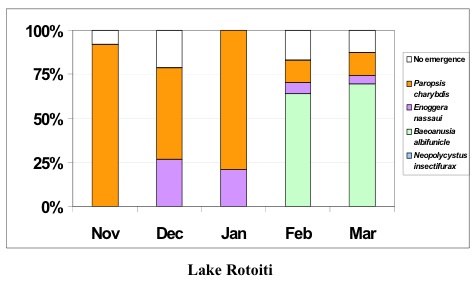PESTS AND DISEASES OF FORESTRY IN NEW ZEALAND
Eucalyptus tortoise beetle update June 2004
Scion is the leading provider of forest-related knowledge in New Zealand
Formerly known as the Forest Research Institute, Scion has been a leader in research relating to forest health for over 50 years. The Rotorua-based Crown Research Institute continues to provide science that will protect all forests from damage caused by insect pests, pathogens and weeds. The information presented below arises from these research activities.
From Forest Health News 141, June 2004.
 Paropsis charybdis ravages eucalypt foliage. In last month’s issue of Forest Health News, we described the discovery of the ladybird Cleobora mellyi at Havelock, demonstrating that this insect has widened its distribution in eucalypt plantations in the Marlborough Sounds region (FHNews 140: 1). This was one of the agents introduced during the 1970s and 1980s in an effort to control the serious eucalypt pest, Paropsis charybdis . Although Cleobora failed to establish in North Island stands, Paropsis populations have until now been controlled effectively by another introduced insect, Enoggera nassaui. However, 2 years ago Forest Health News reported that Enoggera was being attacked by a hyperparasitoid, Baeoanusia albifunicle , which resulted in an upsurge in Paropsis numbers and extensive crown damage in many Eucalyptus nitens plantations. So what’s been going on since then? In this issue we describe recent work on Paropsis control undertaken by Forest Research entomologists, and consider future management of this pest.
Paropsis charybdis ravages eucalypt foliage. In last month’s issue of Forest Health News, we described the discovery of the ladybird Cleobora mellyi at Havelock, demonstrating that this insect has widened its distribution in eucalypt plantations in the Marlborough Sounds region (FHNews 140: 1). This was one of the agents introduced during the 1970s and 1980s in an effort to control the serious eucalypt pest, Paropsis charybdis . Although Cleobora failed to establish in North Island stands, Paropsis populations have until now been controlled effectively by another introduced insect, Enoggera nassaui. However, 2 years ago Forest Health News reported that Enoggera was being attacked by a hyperparasitoid, Baeoanusia albifunicle , which resulted in an upsurge in Paropsis numbers and extensive crown damage in many Eucalyptus nitens plantations. So what’s been going on since then? In this issue we describe recent work on Paropsis control undertaken by Forest Research entomologists, and consider future management of this pest.
PAROPSIS UPDATE
Since 1987, Enoggera nassaui has been the key biological control agent of the eucalyptus tortoise beetle Paropsis charybdis. However, its effectiveness has been compromised by the discovery in 2001 that E. nassaui is itself being attacked by an obligate hyperparasitoid, Baeoanusia albifunicle (FHNews 117:1). To find out what is really happening, Forest Research entomologists undertook monitoring studies during the summer of 2002–03 in Eucalyptus nitens plantations in the central North Island, and the results of this work were reported last year (FHNews 130:1). As a result, further monitoring was conducted in these plantations during the summer of 2003–04 (refer graphs).


This revealed a similar trend to that found during the previous year, with E. nassaui successfully parasitising up to 30% of P. charybdis eggs during early summer. Unhappily, B. albifunicle was again already present in samples in December and by late summer E. nassaui was hyperparasitised and rendered inoperative in an average 60% of parasitised eggs. This led to a drop in the effective parasitism of Paropsis eggs to about 7% on average, and the percentage of viable Paropsis eggs correspondingly ranged from 0 to 37%.
Despite this, there was optimism that biological control would be restored with the subsequent appearance of another Paropsis parasitoid, Neopolycystus insectifurax , because unlike E. nassaui this agent is not hyperparasitised by B. albifunicle . To promote its spread, N. insectifurax was mass reared and released at five central North Island sites during the 2002–03 summer, including two that were being monitored. Results were encouraging, with parasitism of Paropsis reaching 86–100% by March. Based on this information further releases were made at eight sites during the 2003–04 summer, but N. insectifurax was not detected during the monitoring of one of these locations in 2003–04. A population of N. insectifurax was found at Waikite, but only 3% parasitism of Paropsis was achieved in this stand by March 2004, compared to 44% in March 2003. Nevertheless, although parasitism was lower this year, its continued presence provides hope that populations of N. insectifurax may become more widely established.
The future control of Paropsis remains uncertain. It appears that E. nassaui will be effective in reducing population numbers during early summer. However, control of the second generation later in the season is in doubt because of the presence of B. albifunicle and the uncertainty as to whether releases of N. insectifurax will provide effective control. This needs to be determined by further follow-up monitoring. In the meantime, comparative laboratory studies of the attack behaviour and efficacy of N. insectifurax and E. nassaui are continuing as part of an ongoing FRST-funded research programme.
Diane Jones and Sarah Mansfield, Forest Research
This information is intended for general interest only. It is not intended to be a substitute for specific specialist advice on any matter and should not be relied on for that purpose. Scion will not be liable for any direct, indirect, incidental, special, consequential or exemplary damages, loss of profits, or any other intangible losses that result from using the information provided on this site.
(Scion is the trading name of the New Zealand Forest Research Institute Limited.)



